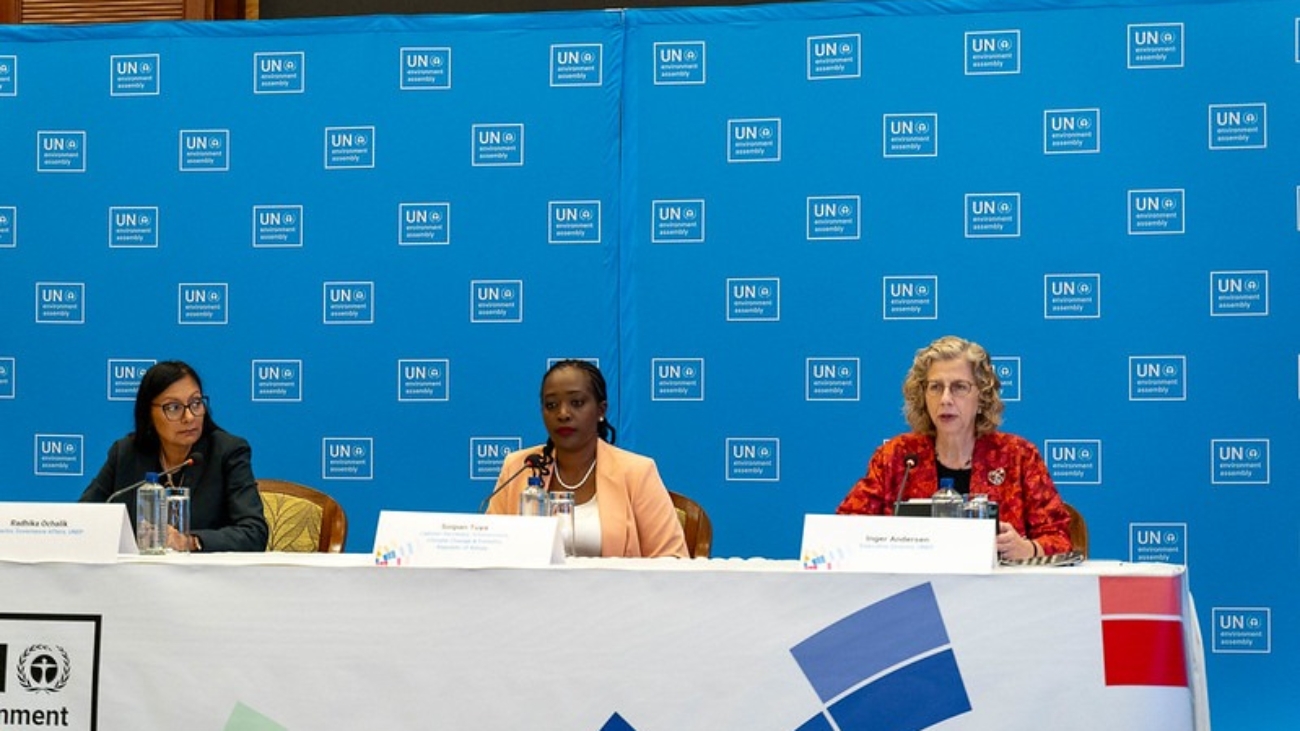KEPSA and WRAP Strengthen Partnership to Tackle the Challenges of Plastic Pollution in Kenya
The Kenya Private Sector Alliance (KEPSA), through Sustainable Inclusive Business (SIB-K), hosted WRAP (Waste and Resources Action Programme) CEO Ms. Harriet Lamb this week. WRAP is a climate action NGO working worldwide on plastics, food loss and waste, textiles, and a circular economy to tackle the causes of the climate crisis and give the planet a sustainable future. It operates in 40+ countries, including Kenya, where it works directly with the Kenya Plastics Pact (KPP).
“WRAP has remained an instrumental strategic partner to KEPSA through our knowledge center, SIB-K, since 2020, and we’re excited to scale our collaboration to address the pressing issue of plastic pollution in Kenya actively. As the private sector, we understand the urgency of reducing the amount of unsustainable plastic packaging being produced in the market and are working collaboratively to increase the adoption of innovative solutions that create more sustainable alternatives,” said Ms. Carole Kariuki, KEPSA CEO, during a meeting held in Nairobi.
The strengthening of this partnership underscores both organizations’ commitment to sustainable development and environmental stewardship.
Ms. Lamb commented, “Plastic pollution is a global challenge that requires collective action and collaboration. We are excited to explore further areas of partnership with Sustainable Inclusive Business under KEPSA and support their efforts to combat waste pollution in Kenya. This can drive meaningful progress towards a more sustainable future and create lasting benefits for our environment, economy, and society.”
WRAP, along with partners the Ellen MacArthur Foundation, convenes the Plastics Pact Network, a globally aligned response to plastic waste and pollution based on the New Plastics Economy vision for a circular economy for plastic. The Plastics Pact Network is a unique platform to exchange learnings and best practices with other countries and regions to accelerate the global transition to a circular economy for plastics, with the Kenya Plastics Pact (KPP) spearheading activities in Kenya. Other national plastic pacts include those in the UK, France, Chile, the Netherlands, Portugal, the US, South Africa, Poland, Canada, India, and Colombia. Regional pacts include the Australia, New Zealand, and Pacific Islands (ANZPAC) Plastics Pact.
The Kenya Plastics Pact enables concerted action towards creating a circular economy for plastic packaging. All stakeholders sign up for a joint set of ambitious and time-bound targets, ensuring this collaboration will drive significant change by 2030. This vision will be made a reality by, among others, collectively implementing a clearly defined roadmap to 2030 and co-designing and implementing pioneering and collaborative projects across the country.
“Having been largely involved in developing the Extended Producer Responsibility (EPR) regulation, we are now focusing on working closely with producers, the government, and partners to support successful implementation. I encourage more companies to put their weight behind the Kenya Plastics Pact – as I believe the model is a constructive multi-stakeholder blueprint for mobilizing the private sector players to create circular systems in the plastics sector and beyond, including others like food and textiles,” added the KEPSA CEO.
By working together with its members and partners, the Kenya Plastics Pact is working to, among others implement and scale activities under the KPP Roadmap to 2030 to reduce waste generation across the plastics value chain, promote the adoption of sustainable packaging alternatives and encourage investing in circular product designs and recyclable materials and increase awareness among businesses, consumers, and policymakers about responsible production, consumption, and waste management practices.
Further, the KPP advocates for and support policy reforms and regulations that support a circular economy for plastic packaging and facilitate the transition to a zero-waste future and collaborates with private sector stakeholders, government agencies, and non-profit organizations to maximize impact and drive systemic change.
Proactively addressing the challenges of climate change and plastic waste pollution will help amplify the Kenyan voice and contribute meaningfully to global efforts like the Global Plastics Treaty. This means urgently accelerating sustainable production and consumption of plastics from re-designing packaging to sustainable waste management practices. These efforts will unlock barriers to fast-tracking a circular economy with improved economic, environmental, and societal outcomes, such as stimulating industry-led innovation, generating job opportunities, and creating behavioral change.
Under KEPSA, Sustainable Inclusive Business – Kenya fosters collaborations, spearheads multi-stakeholder initiatives, conducts research, pilots innovative projects, and promotes awareness and action across four thematic areas: Circular Economy, Climate Change and Biodiversity, Empowering People and Societies, and Redefining Businesses Values.
$12 trillion needed to triple global renewables by 2030
By Checky Abuje
Investment in Africa needs to grow five-fold to ramp up renewables twice as fast as global average.
According to the new report by Climate Analytics, $8 trillion of investment is needed for new renewables and $4 trillion for grid and storage infrastructure to deliver the 2030 tripling goal agreed at COP28 – or combined, $2 trillion a year on average. Using climate finance to mobilise $100 billion a year for the rollout in Sub-Saharan Africa, five times current investment levels which will ensure energy access for all and align the region with the global target.
“$2 trillion a year sounds like a cost, but it’s really a choice. We’re set to invest over $6 trillion in fossil fuels over this decade – more than enough to close the tripling investment gap. Faced with this choice, I’d go with the safest, best value option – renewables,” says the report’s lead author and Climate Analytics expert Dr Neil Grant.
The report however calculates how fast different regions need to act to triple global renewables based on current capacities and future needs. Renewable capacity in Sub-Saharan Africa needs to scale rapidly by a factor of seven (double the global average) due to historic underinvestment and energy access needs. The OECD is forecast to double its renewables by 2030, but it needs to triple.
Accelerating action in line with this would close 60% of the global gap between forecast capacity in 2030 and the tripling goal.
“The OECD needs to triple renewables but is currently way off target. Countries in the region claiming to be climate leaders need to walk the talk, not just by ramping up renewables at home, but by coming through for other regions which need finance to contribute to the tripling goal,” says Claire Fyson, co-author on the report and Head of Policy at Climate Analytics.
Asia needs to scale slightly faster than the OECD, almost quadrupling its renewable capacity by the end of the decade. Asia is the only region broadly on course for the tripling goal, driven mostly by policies in China and India.
However, the significant coal and gas pipelines in these countries risks stranded assets or slowing the transition. As renewables are set to grow strongly in the region, new fossil fuel plants are not needed and should be avoided.
“The renewables industry stands ready to deliver on the global tripling goal. But to get there in time, we need governments to take urgent action to turbocharge an already buoyant renewables market. Public finance is key, especially international support to provide access to low-cost capital for emerging markets to join the renewables era, ensuring a clean, secure and just transition for all,” says Bruce Douglas, CEO of the Global Renewables Alliance in reaction to the report.
Tripling renewables by 2030 is not the end of the story. The report finds renewables need to continue growing strongly beyond the end of the decade, scaling up five times by 2035 relative to 2022, to limit warming to 1.5°C. As governments start to develop their 2035 targets for the next round of NDCs, they should consider how to follow through on the tripling ambition collectively agreed at COP28.
Kenya Ready for the UNE-6
By Hon. Soipan Tuya
As Kenya, we are, once again, proud to welcome to Nairobi all delegates from the 193 United Nations Member States including Heads of State and Government; colleague Ministers of Environment and other high-ranking Dignitaries and UN Officials for the 6th Session of the United Nations Environment Assembly (UNEA-6) from 26th February to 1st March this year under the Presidency of the Kingdom of Morocco with the theme “Effective, inclusive, and sustainable multilateral actions to tackle climate change, biodiversity loss and pollution”.
As you may be aware, UNEA is the world’s highest-level decision-making body for matters related to Environment. UNEA sets the global environmental agenda, provides overarching policy guidance and defines policy responses to address emerging environmental challenges. Most importantly, UNEA undertakes environmental policy review and provides strategic direction for the UN Environment Programme (UNEP).
UNEA-6 has been organised around six thematic areas that were considered by members in developing the draft resolutions to compel more effective, inclusive and sustainable multi-lateral action. As a result, twenty-two resolutions have been developed and are being negotiated by the member states along five clusters.
It is a privilege for Kenya to host UNEA every two years in Nairobi by virtue four Country being the global headquarters of UNEP, which is one of the two United Nations agencies headquartered in the Global South. The other one being UN Habitat which is also headquartered here in Nairobi.
Kenya continues to live up to its high international ranking as the environment capital of the world by being a trailblazer in climate action. In September last year, Kenya hosted the inaugural Africa Climate Summit in Nairobi, a 3-day high level conference, held alongside the 2023 annual United Nations Framework Convention on Climate Change (UNFCCC) Africa Climate Week, during which the African Leaders Nairobi Declaration on Climate Change and Call-to-Action was agreed upon and unveiled.
The Nairobi Declaration as the blueprint is popularly referred to, carries Africa’s climate action aspirations and has since become the continent’s main reference document at international fora including the 28th United Nations Conference of Parties (COP28) in Dubai, The UAE. At the core of the Nairobi Declaration, is Africa’s resolve to pursue green growth by leveraging her immense climate action potential in sectors such as renewable energy, sustainable agriculture, critical minerals and blue economy among others.
As Kenya, we are actively integrating the Nairobi Declaration into our Country’s broad climate action agenda including reviewing our laws, regulations, strategies and programmes to reflect Africa’s climate action priorities as documented in the Nairobi Declaration. For example, and as you may know, last year we successfully amended the Climate Change Act to provide for a more progressive carbon markets framework. Following last week’s public participation meeting, we are now at the tail-end of establishing regulations to back the Climate Change Act. We are also reviewing the Forest Act, the Environmental Management and Coordination Act (EMCA) and its regulations among others. Kenya’s first ever National Forest Policy was recently passed and its main objective is to provide a framework for improved forest governance, resource allocation, partnership and collaboration. Further, last year, we made history by recruiting, training and successfully deploying a record 2,664 Forest Rangers.
Kenya is also accelerating the transformation of Kenya’s lineal waste management system into circular economy. As a result, Kenya will hold a side event on circular economy during UNEA-6 to appreciate the strides the country has made in implementing waste polices to address pollution control and best practices in circular economy and extended producer responsibilities.
His Excellency President Dr. William Ruto’s administration is clear on the need for solutions to our environmental challenges illustrated in the Bottom-up Economic Transformation Agenda (BETA), the Kenya Kwanza Manifesto (The PLAN) and demonstrated through some of the programmes we are rolling out as a Country. Kenya’s National Landscapes and Ecosystem Restoration Strategy, the anchor blueprint for the flagship 15 Billion National Tree Programme that gave our Country the first National Tree Growing Day (Green Holiday) on 13th November last year is one such ambitious initiative that we are fully committed to as a Ministry and as a Government.
As part of Kenya’s deep commitment to achieving 30% tree cover by 2032 through growing of 15 Billion trees, 30% of which will be fruit and fodder species to contribute to our Country’s food and nutritional security and household incomes, the over 6,000 delegates expected in Nairobi for UNEA-6 will all be requested to take time off and grow trees at sites to be communicated.
It is also important to note that as host President and Chairperson of the Committee of the African Union Heads of State and Government on Climate Change (CAHOSCC), His Excellency President Dr William Ruto will deliver UNEA-6 National and Welcoming Statement on 29th February 2024 at the high-level segment that will be attended by several other visiting Heads of State and Government, and dignitaries. On the same day in the evening, and in line with the established UNEA tradition, I will host a reception for all delegates during which we will showcase Kenya’s world celebrated hospitality.
During the entire duration of UNEA-6, February 26th to March 1st, there will be a showcase of Kenya’s rich cultural heritage, climate action potential and touristic offering to visiting delegates at the venue. We thank UNEP for allowing us to set up Kenya House at the venue.
UNEA-6, will, without doubt, be an intense week of many related activities including bilateral meetings and hundreds of side events. I encourage media to keenly follow the conversations and report outcomes of these meetings.
As the host country, we look forward to the outcome of UNEA 6 being the Ministerial Declaration, the adoption of the resolutions and decisions and that UNEA-6 will enhance the solutions to the Triple Planetary Crisis of Climate Change, Biodiversity Loss and Pollution.
The writer is the Cabinet Secretary, Ministry of Environment, Climate Change and Forestry of Kenya
Climate Investment Funds Endorses Kenya’s $70 million Plan for 100 percent Clean Energy
The Trust Fund Committee of the Climate Investm ent Funds (CIF)has endorsed a $70 million plan, with an initial allocation of $46.39 million, to advance the integration and utilisation of renewable energy in the Kenyan grid, enabling the country’s transition to 100 percent clean energy by 2030. This approval, as part of CIF’s Renewable Energy Integration (REI) investment program, will support Kenya’s ambition to reduce greenhouse gas emissions by 32 percent by 2030 and achieve Net Zero by 2050.
The initiative will see Kenya’s CIF REI plan support access to clean, adequate, affordable, and reliable electricity in the country. It is expected to mobilize at least an additional $243 million from the public and private sectors through implementing partners—the African Development Bank and the World Bank Group.
Currently, the share of renewable energy in Kenya is almost 90 percent – including 45 percent geothermal and 26 percent hydropower,but the system faces challenges. During evening hours, it struggles to meet peak demand, but later, at night, generation surpluses from geothermal and wind are sometimes not dispatched.
Kenya’s REI investment plan will improve dispatch, grid stability, and flexibility to address these issues. It will facilitate future private sector investment in innovative storage technologies, such as battery storage and pumped hydropower. The energy system will also be better prepared for a significant increase in electric mobility and cooking. The plan contributes to the expansion of variable renewable energy, such as wind and solar, from 19 percent to 30 percent by 2030.
CIF has established the pioneering REI program precisely to address the issues linked to the deployment of clean and intermittent power sources in developing economies. REI can support a mix of supply/demand side flexibility measures— enabling technologies, enabling infrastructure, market design and system operations improvement, and electrification and demand management; while advancing social inclusion and leveraging private sector financing.
Ten countries have been selected to take part in this program, with Brazil, Colombia, Costa Rica, Fiji, and Mali’s investment plans endorsed by the CIF Trust Fund Committee in 2023.
Knight Science Journalism Program (KSJ) announces Fellowship for Advancing Science Journalism
The Knight Science Journalism Program (KSJ) has announced Fellowship for Advancing Science Journalism at the Massachusetts Institute of Technology (MIT).
The fellowship aims to enrich the training of a journalist from Africa or the Middle East so they can contribute to a culture of high-quality science and health journalism in those regions, as well as raising awareness of regional advances in the rest of the world.
This new one-semester fellowship created in partnership with Springer Nature, publisher of Nature Middle East, which grew to be an important contributor to science reporting. It was inspired by the life and career of Egyptian science journalist Mohammed Yahia’s leadership from 2010-2023.
The fellow will join other KSJ fellows in a program of study at MIT and other Cambridge/Boston area universities and in the program’s seminars, training workshops and field trips throughout the semester.
To be eligible for the fellowship, applicants must:
Be journalists based in Africa and/or the Middle East with at least three years’ experience reporting on science, health or environmental issues in the region.
Be reporters, writers, editors, producers, illustrators, filmmakers, or photojournalists. This includes work for newspapers, magazines, television, radio, and digital media.
For more, read
Ivorian space scientist to lead STI Division of the AU
Ivorian Dr Tidiane Ouattara is the new Head of the Science, Technology and Space Division at the African Union Commission’s Department of Education, Science, Technology and Innovation.
In this capacity, Dr Tidiane will lead efforts to formulate, harmonise, coordinate, and implement policies that will transform the continent into an innovation-led and knowledge-based economy.
The Division of Science, Technology and Space raises the awareness on the central role of science, technology and innovation (STI) in socio-economic development; promotes public understanding and participation, building human and institutional capacities for STI.
Dr Ouattara previously worked as a lecturer at his alma mater, Sherbrooke University, Canada, and then with the Canadian government in various space application and management roles covering earth observation, policy and research, strategy, and international relations. He joined the AU in 2016 where he served as the GMES & Africa Programme Coordinator, an AU-EU joint initiative funded by the European Commission.
Dr Tidiane Ouattara has a PhD and a master’s degree in Remote Sensing and Geographical Information Systems (GIS) from Sherbrooke University, Quebec, Canada and a master’s degree in Physical Geography from Université de Cocody, Abidjan, Côte-d’Ivoire.
$15M additional funding to tackle food waste around the world
Work tackling the huge environmental cost of food waste has been given a massive boost this year, as international climate action NGO WRAP receives catalytic funding from the Ballmer Group.
The $15M funding will support essential work by WRAP and our partners in tackling food loss and waste through existing Voluntary Agreements in South Africa, Australia, Indonesia, Mexico and to create a new food waste voluntary agreement in Brazil. The funding covers ongoing work with money allocated to each nation to increase the systemic Target-Measure-Act approach to reduce food waste across supply chains and in the home, which globally are responsible for around 10% of all Greenhouse Gas (GHG) emissions.
David Rogers, International Director at WRAP said, “This funding is an absolute game-changer, and the largest philanthropic donation WRAP has received for our work around the world. It marks a transformational moment, bringing substantial, multi-year funding to scale up the impact of food waste voluntary agreements around the world. We know the model works, having proven it first in the UK before working with our excellent partners to support them in adapting it to local contexts and challenges. We are incredibly grateful to The Ballmer Group for the funding at this critical time, with just six years left to halve food waste by 2030.”
The Public-Private Partnership model, or Voluntary Agreement, utilises a Target-Measure-Act approach to coordinate and drive action by key partners along the global supply chains that produce our food. They can deliver significant and lasting reductions in food waste with the model proving particularly successful in the UK, where the Courtauld 2030 voluntary commitment has seen retailers and manufacturers cut their business food waste by nearly 30%.
WRAP has helped to establish and support six food pacts, building from the blueprint of the Courtauld 2030 model. The climate action NGO is working with the partners delivering the agreements in each nation as they adapt the approach to suit their unique situations. Together, this international network provides a co-ordinated group of actors aligned to a shared ambition, mirroring the approach WRAP instigated to tackle plastic pollution through a series of national Plastics Pacts.
The announcement of the grant follows the recent publication of the Philanthropic Roadmap’ (Reducing Food Loss and Waste – A Roadmap for Philanthropy).
Involving 50 expert organisations and led by the Food and Land Use Coalition (FOLU), WRAP, ReFED and the World Resources Institute (WRI). With funding from the Bezos Earth Fund, the Betsy and Jesse Fink Family Foundation, the IKEA Foundation and the Robertson Foundation, the Philanthropic Roadmap gives a blueprint identifying $300,000,000 in ready-to-fund philanthropic investments that can deliver major improvements for the climate, economy, and society by cutting food waste. National coordination through voluntary agreements is viewed as a major route to driving change.
“We have the partnerships, the framework, and the expertise to make inroads into global food waste, but what’s been missing has been serious investment at the global level. That’s why support by The Ballmer Group, and the creation of a dedicated ‘Philanthropic Roadmap’, are such important developments. Both can help fix our failing food system and help tackle climate change, and both show that investment – whether philanthropic or governmental – are crucial to help repair our failing food system,” said David Rogers.
WRAP’s work around the world
With offices in the UK, Australia and the USA, WRAP works globally with governments, businesses, and communities to deliver practical solutions to improve resource efficiency within the food system, plastics and in textiles. The organisation takes UK learning and successes and works with in-country partners to develop programmes that fully address the needs of the local area. It has programmes operating in Africa, Asia and the Pacific, Europe and the Americas. It recently brought representatives from Red de Bancos de Alimentos de México (BAMX) and the Indonesia Business Council for Sustainable Development (IBCSD) to COP28 to outline the impact public-private partnerships are making in those countries.











